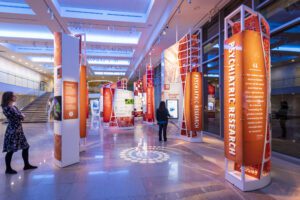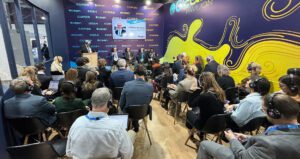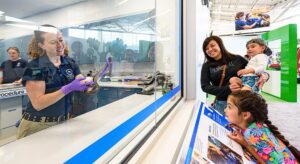Conservation Connection: Local Lessons, Global Importance
How CambridgeSeven's work with zoos, aquariums, museums and research institutions strengthens their conservation education efforts.
View PostScientists and researchers conduct extraordinary work but sometimes struggle with getting the word out. Science can be mired in mystery and obfuscated by technical terminology, so the challenge is to translate it into something easily understood, yet accurate and engaging.
Communicated well, science is thrilling, hopeful and heroic and we work with several institutions that understand the value of illustrating the relevance of their research in engaging and creative ways that educate and inspire. Whether sparking young minds or securing precious funding, there’s a critical imperative to reach audiences beyond the lab benches.

The Broad Institute of MIT and Harvard is a world-renowned organization progressing cutting-edge biomedical and genomics research. Their dedicated researchers aim to understand the basis of many infectious diseases, genetic diseases and cancer, as well as how to engineer the human genome. In 2022 the Broad opened their new, public-facing educational space, the Broad Discovery Center, designed by CambridgeSeven.
Our team started design for the Discovery Center in 2019, with the goal of crafting an exhibit space that could convey complex, but vital, research topics to the general public. It was also important that these flexible exhibits could physically adapt to different programmatic needs of the Institute and be easily updated as research topics and findings evolve over time. Little did our team know how timely this project would become when, just a few months into the design process, the world first faced the COVID-19 pandemic. It became acutely important to give the Broad a vehicle to showcase their work and share accurate scientific messaging with the community.
The exhibit pylons, which visually mimic DNA double helix structures, display text, graphics, and interactive LED screens with information about cancer, psychiatric research, and infectious diseases. As the pylons are visible from the street outside, the Discovery Center is literally the public face of the Broad Institute, increasing awareness of a knowledge base the community might not have otherwise known was available to them and creating an accessible source of accurate and reliable information.
The Discovery Center is now one of the stops along the Innovation Trail – a network of sites throughout Cambridge and Boston that highlight historic scientific and technological accomplishments. Broad is in good company with 20 other notable sites, labs and museums, including another CambridgeSeven client – the Museum of Science.

Among the methods that scientific organizations use to share their work with the greater public, we can look at ideas that reach beyond the walls of where they conduct their research… literally.
This is the approach of Resilient Woods Hole (RWH) – a project that showcases the collaborative research of the Woods Hole Oceanographic Institution (WHOI), Marine Biological Laboratory (MBL), National Oceanic and Atmospheric Administration (NOAA) and the Town of Falmouth, Massachusetts. This initiative focuses on addressing the growing impacts of climate change in the village of Woods Hole, the Falmouth community where the institutions are based. Not only does Resilient Woods Hole convey the impacts of climate change on this area, it also showcases strategies to mitigate these impacts. The threat of sea level rise and storm surge poses real-life challenges to Woods Hole and similar communities and this project highlights information that could very well be lifesaving in the near future.
Woods Hole, a popular stop for seasonal visitors, is well situated for integrating science information into the visitor experience, with thousands of daily visitors and locals strolling the streets of this seaside community. The collaborative created the Resilient Woods Hole Climate Walking Trail – a series of educational installations throughout the coastal village that one might stumble upon intentionally or accidentally. By sharing their research in the public realm, meeting people where they are, RWH increases both the accessibility of information and the likelihood of people absorbing it. Placing these interactive installations about seawater directly at the water’s edge makes the information all the more meaningful and relevant to community members’ daily lives.

We can also look to the example set by the Atlantic Council with their Adrienne Arsht-Rockefeller Foundation Community Resilience Pod – a shipping container repurposed as a mobile information hub that shares information and resources regarding how climate change is impacting the Miami-Dade region and how people can prepare for future natural disasters. The pod can travel to the county’s most at-risk communities to inform them how to best prepare for extreme heat, flooding, and storm surges. A blend of custom-curated artwork and vibrant infographics give the pod its own identity and make it easily identifiable in public spaces. Similarly, the pavilions that CambridgeSeven has designed for multiple United Nations Climate Conferences, such as the Ocean Pavilion at COP 29, are temporary communication tools that serve as sites for dialogue surrounding the importance of our oceans and natural resources. Wrapped in immersive environmental graphics, these engaging info hubs are part event space, part exhibit, and part demonstration project– with their locally-sourced, reusable materials– for messaging about climate resiliency.

To hear some kids tell it, they spend every single day in school and they would love to be elsewhere. Children and teenagers are also feeling more overwhelmed and over-stimulated than ever before. We know that not all children learn the same way; some perform well in a classroom environment while others require non-traditional learning opportunities in order to thrive. Research institutions like zoos and aquariums know how important it is to appeal to young learners to instill their messaging in growing minds. This helps develop lifelong passion for environmental and ecological conservation. But competing for attention is a real issue in today’s media-, AR-, and AI-saturated environment. So, what does it take to keep young learners engaged and interested in important topics?
“In the past, we would do these projects behind the scenes. Our guests never got to see the work that we were doing. Now, we have been able to create these Windows to Conservation, so you can look right in and see these animals as we raise them and explain their destination, whether that’s another accredited zoo or aquarium, as ambassadors, or whether they can be put back into the environment, which is, of course, our ultimate goal.”
Cynthia Whitbred-Spanoulis President and CEO of Virginia Aquarium
Take the Virginia Aquarium and Marine Science Center’s recent expansion as a case study for some ideas. Large windows let visitors see directly into back-of-house spaces that are typically closed off from the public eye. Here, visitors can see, and even interact with, professionals and staff as they care for the animals. Exhibits are enlivened with super-hero-themed graphics and pop-art colors, creating a distinct and memorable learning environment designed to instill curiosity and wonder about marine creature adaptation and local watershed ecosystems.
Or look to the North Carolina Aquarium on Roanoke Island, an institution that takes full advantage of its facility by offering a variety of programs and events that utilize their exhibits and tanks, outdoor spaces, and even their back-of-house spaces that they open up to groups interested in learning about animal care. Exhibits highlight local ecologies and habitats of the southern U.S. with emphasis on the important functions of wetlands.
Giving a public face to scientific and research organizations, especially when done creatively, helps to share vital information with wide audiences. Research and cultural organizations enrich our cities and towns, fuel economies, and progress life-changing findings that define our society. As some of these organizations are reliant on fluctuating funding and grants, generating support and buy-in from individual and private-sector sources can be crucial. Additionally, supplementing in-classroom-learning with enriching experiences outside of the classroom helps to ensure that the future of science is in safe hands.
How CambridgeSeven's work with zoos, aquariums, museums and research institutions strengthens their conservation education efforts.
View PostMadeline Burns, AIA, LEED AP BD+C, CPHC highlights the importance of naturally biodiverse native landscapes in urban settings and what designers can do to create environments that are both sustainable and good design.
View PostJustin Crane, FAIA explains ten different ways architects can design while lessening negative impacts on wildlife and natural habitats.
View Post